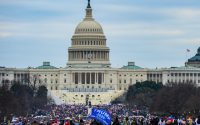Supreme Court Had Conservative Triumphs This Term, but Also Showed New Caution
The Supreme Court ended its term this week in familiar fashion, issuing blockbuster conservative decisions on affirmative action, gay rights and student loans that divided along partisan lines, with the court’s three Democratic appointees in dissent.
While not quite as stunning as last June’s decisions eliminating the right to abortion and expanding gun rights, the new rulings were of a piece with them and were a further indication that the court remains receptive to the conservative legal movement’s agenda, including cutting back on a progressive conception of civil rights and frustrating President Biden’s initiatives.
But the entire story of the most recent term is considerably more complicated than that of the previous one, which had seemed to establish an unyielding conservative juggernaut characterized by impatience and ambition — and built to last.
A year later, the court remains deeply conservative but is more in tune with the fitfully incremental approach of Chief Justice John G. Roberts Jr., who is attentive to his court’s legitimacy, than with the take-no-prisoners approach of Justice Clarence Thomas. The chief justice’s strategy — and votes — produced a fair number of liberal victories.
“Chief Justice Roberts seems to be getting at least some of the conservative majority back into harness on incremental moves,” said Pamela S. Karlan, a law professor at Stanford.
Indeed, the term that just ended was something of a triumph for the chief justice, who just a year ago seemed to be losing power, having failed to persuade a single colleague to join his compromise position in the case that did away with the constitutional right to abortion.
When the latest term started in October, Justice Thomas appeared to have gained control of the court for the first time in his more than 30-year tenure, said Richard J. Lazarus, a law professor at Harvard.
“Those tables have dramatically turned,” Professor Lazarus said. “Although the chief justice has struggled mightily under rising public expectations to address ethical issues within the court, mostly focused on Justice Thomas, the chief rather than Thomas remains the most influential justice on the court in terms of the outcomes in the court’s opinions.”
Indeed, Chief Justice Roberts was in the majority in divided cases decided by signed opinions 86 percent of the time, second only to Justice Brett M. Kavanaugh, at 90 percent. Justice Thomas was last by this measure, at 55 percent.
Thanks largely to alliances with Chief Justice Roberts and one or more of President Donald J. Trump’s three appointees — Justices Kavanaugh, Neil M. Gorsuch and Amy Coney Barrett — the court’s three liberals were in the majority in a considerable number of important cases. They included ones on the Voting Rights Act, immigration, the role of state legislatures in elections and Native American rights.
The three liberals were on the winning side more often than the court’s two most conservative members, Justices Thomas and Samuel A. Alito Jr.
“Looking across the entire docket — not just the term’s last two days — the data show a shift from the most conservative and aggressive court in modern history to one that has moderated,” said Lee Epstein, a law professor and political scientist at the University of Southern California. “Perhaps the justices — especially Roberts, Barrett and Kavanaugh — have faced up to the public’s waning confidence and decided to self-adjust. The red team versus the blue team in case after case isn’t a good look.”
The percentage of unanimous decisions grew, by a large margin, to 47 percent from last term’s 28 percent. That, too, is evidence of efforts to forge consensus.
Some conservatives have been frustrated. Gov. Ron DeSantis of Florida, a Republican and a rival to Mr. Trump for the Republican presidential nomination, recently said that none of Mr. Trump’s three appointees “are at the same level” of Justices Thomas and Alito.
Josh Blackman, a law professor at South Texas College of Law Houston, said the critique had force from a conservative perspective, and he questioned the adequacy of the Trump administration’s vetting process, which relied on lists of potential nominees compiled by lawyers with ties to conservative legal groups like the Federalist Society and the Heritage Foundation.
“For different reasons, Justices Gorsuch, Kavanaugh and Barrett have and will continue to disappoint conservatives,” Professor Blackman said. “I don’t know that future ‘short lists’ are worth much if they are made by the same people who generated the last batch of lists.”
Still, some of the biggest victories for liberals came in cases where the court rejected assertive arguments and merely maintained the status quo.
“There were instances where conservative litigants overplayed their hand and lost out,” said Elizabeth Wydra, the president of the Constitutional Accountability Center, a liberal group.
And even some of those victories came with caveats.
In one, Justice Barrett, writing for seven justices, rejected an equal protection challenge to the Indian Child Welfare Act, a federal law that seeks to keep Native American children with their tribes. But she did so on the ground that the challengers lacked standing. In a concurring opinion, Justice Kavanaugh stressed that the issue remained alive and that the court could address it in a later case.
Similarly, in a surprise win for minority voters in Alabama in which Chief Justice Roberts was joined by Justice Kavanaugh and the three liberals in rejecting a challenge to the Voting Rights Act, Justice Kavanaugh issued a concurring opinion saying that it was possible that “the authority to conduct race-based redistricting cannot extend indefinitely into the future.”
Regardless, data compiled by Professor Epstein, Andrew D. Martin of Washington University in St. Louis and Kevin Quinn of Emory University all point in the same direction: In the scheme of things, the liberal wing had a reasonably good term.
The three liberals as a group were in the majority in divided decisions at a rate of 64 percent, compared with 73 percent for the six conservatives. In the previous term, the liberals trailed the conservatives by 34 percentage points, the largest gap in at least a decade.
Alliances shifted. Chief Justice Roberts voted with Justice Elena Kagan, a liberal, about 62 percent of the time, a 14 percentage-point jump from the last term, and with Justice Thomas just 48 percent of the time, a 21-point drop. Justice Kavanaugh voted with Justice Ketanji Brown Jackson, appointed to the court by President Biden, about 62 percent of the time and with Justice Thomas less than 45 percent of the time.
Roman Martinez, a Supreme Court specialist with Latham & Watkins, said that “members of the conservative bloc — and especially the chief justice and Justice Kavanaugh — found common cause with the more liberal justices on a surprising range of issues.”
Another way to assess the term is to look at the American Civil Liberties Union’s success rate. The group filed briefs in 18 argued cases and was on the winning side in 11 of them.
David Cole, the group’s national legal director, said losses in the affirmative action and gay rights cases were “unprecedented setbacks for equality.”
“But beyond that,” he said, “civil liberties and civil rights fared surprisingly well this term — far better than anyone predicted. The court avoided partisan divides and reached rights-protective results in important cases involving redistricting, Native American rights, victims of discrimination, prisoners’ access to court, social media, free speech and immigration enforcement.”
“What we saw,” he said, “was a reversion to the mean.”
Most of the data in this article concerns signed decisions issued by the court after full briefing and argument. But the court also grew more cautious in the terse orders it issued in response to emergency application on what critics call the shadow docket.
The court allowed a commonly used abortion pill to remain available, blocking a ruling from a federal judge in Texas over the dissents of Justices Thomas and Alito. It let a transgender girl compete on the girls’ cross country and track teams at her middle school in West Virginia while her appeal moved forward. Again, Justices Thomas and Alito dissented.
The docket for the court’s next term, which starts in October, is still taking shape. On Friday, the court agreed to decide whether the Second Amendment allows the government to disarm people subject to restraining orders for domestic violence.
The court is also set to decide two important administrative-law cases. One asks the court to overrule the Chevron doctrine, which requires courts to defer to administrative agencies’ interpretations of federal statutes. The other could hobble the Consumer Financial Protection Bureau.
In the last decision of the current term, on student loans, Chief Justice Roberts concluded his majority opinion, which rejected a key initiative of the Biden administration, with an appeal to the public that seemed to reflect a mix of optimism, naïveté and deep attachment to a court under siege.
He said that sharp exchanges among the justices were the products of good-faith disputes.
“We do not mistake this plainly heartfelt disagreement for disparagement,” he wrote. “It is important that the public not be misled either. Any such misperception would be harmful to this institution and our country.”


